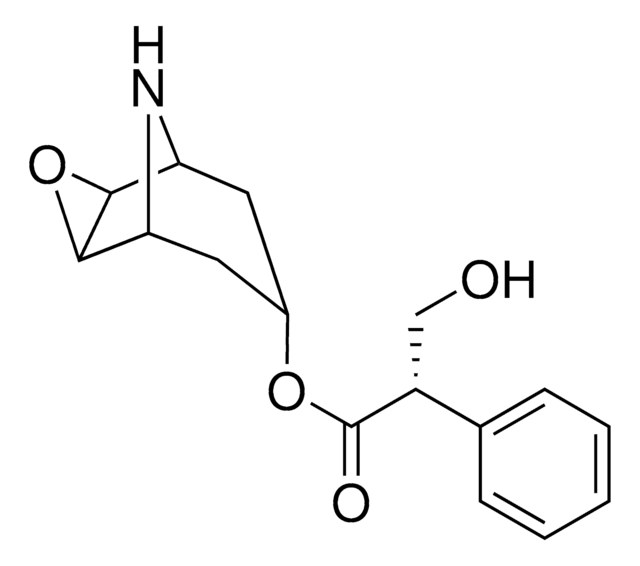S1875
(−)-Scopolamine hydrobromide trihydrate
≥98% (HPLC), powder
Sinônimo(s):
Hyoscine hydrobromide, Scopine tropate
About This Item
Produtos recomendados
Ensaio
≥98% (HPLC)
forma
powder
atividade óptica
[α]25/D −24 to −26°, c = 5 in H2O(lit.)
cor
white to off-white
pf
195-199 °C (dry matter) (lit.)
solubilidade
H2O: 50 mg/mL
cadeia de caracteres SMILES
O.O.O.Br.CN1[C@@H]2C[C@H](C[C@H]1[C@@H]3O[C@H]23)OC(=O)[C@H](CO)c4ccccc4
InChI
1S/C17H21NO4.BrH.3H2O/c1-18-13-7-11(8-14(18)16-15(13)22-16)21-17(20)12(9-19)10-5-3-2-4-6-10;;;;/h2-6,11-16,19H,7-9H2,1H3;1H;3*1H2/t11-,12-,13-,14+,15-,16+;;;;/m1..../s1
chave InChI
LACQPOBCQQPVIT-SEYKEWMNSA-N
Informações sobre genes
human ... CHRM1(1128) , CHRM2(1129) , CHRM3(1131) , CHRM4(1132) , CHRM5(1133)
Procurando produtos similares? Visita Guia de comparação de produtos
Categorias relacionadas
Ações bioquímicas/fisiológicas
Características e benefícios
Palavra indicadora
Danger
Frases de perigo
Declarações de precaução
Classificações de perigo
Acute Tox. 1 Dermal - Acute Tox. 2 Inhalation - Acute Tox. 2 Oral
Código de classe de armazenamento
6.1A - Combustible acute toxic Cat. 1 and 2 / very toxic hazardous materials
Classe de risco de água (WGK)
WGK 1
Ponto de fulgor (°F)
Not applicable
Ponto de fulgor (°C)
Not applicable
Equipamento de proteção individual
Eyeshields, Faceshields, Gloves, type P3 (EN 143) respirator cartridges
Certificados de análise (COA)
Busque Certificados de análise (COA) digitando o Número do Lote do produto. Os números de lote e remessa podem ser encontrados no rótulo de um produto após a palavra “Lot” ou “Batch”.
Já possui este produto?
Encontre a documentação dos produtos que você adquiriu recentemente na biblioteca de documentos.
Os clientes também visualizaram
Artigos
DISCOVER Bioactive Small Molecules for Neuroscience
Nossa equipe de cientistas tem experiência em todas as áreas de pesquisa, incluindo Life Sciences, ciência de materiais, síntese química, cromatografia, química analítica e muitas outras.
Entre em contato com a assistência técnica











